Well, first of all for $300 I would buy them. A lot of speaker for the money. 🙂
Hi and thanks a lot for the suggestion.
The guy is changing his system and he wants something more full range.
I had a lot of issues with my System 800s, which I documented here http://www.diyaudio.com/forums/multi-way/265772-tannoy-system-800-never-sounded-right.html but the Precision 8P seems to be a quite different design with the drivers much better integrated.
The measurement results given here http://resolution.nodecube.net/products/pdfs/Monitoring/Tannoy Precision 8P.pdf are much better than I observed for the System 800s.
Then again, the measurements published in the System 800 manual are also much better than what I actually got, which might make you doubt Tannoy's quality control. 🙁
If the issues you feel can be related to the waveguide well ... i do not think that there is a lot to do. I guess is something in the DNA of the waveguide that can introduce colorations/distortions.
If the problem is in the FR you can tame a little the tweeter, try to wire it with terminal reversed, upgrade the x-over parts.
I think you have a very good monitor with the System 800s.
I also have a pair of KEF LS50s and these blow the System 800s out of the water. I don't think the Uni-Q system is a bodge at all, it is just a different design approach. The Tannoy dual concentric is a classical horn with constant directivity, the Uni-Q is a short conical waveguide with wide dispersion (and better time alignment)
Yes and me too i like the Uni-Q driver better ... the centers of emission are really concentric and the driver is a high class driver indeed.
I read great reviews. But weak on the real bass. A sub is needed to get a complete sound.
This is the time-aligned school of speaker design that aims to reassemble a perfect impulse at the listener's ear. I showed the measurements of the G1 Giya because it is something quite different to time-aligned and yet it works out the same. If they had plotted its phase response, it would still be a nice smooth line, it just wouldn't be horizontal. They have allowed the phase to disperse linearly, to make other aspects of the design easier.
What matters in this school of speaker design is for the decay of each drive unit to match the rise of the next, as you are trying to assemble a chirp out of a bunch of wibbles. Depending on the crossover order, the initial rise could have the same polarity as the decay, or the opposite.
It is a very uncertain issue.
I have seen many speakers with tweeters mounted on a rear plan respect to the woofers (sorry for the English😱)

and they usually have good sound.
I do not know. I like the principle but honestly i do not know how important is to apply it and what are the real benefit.
Talking again about the ls50 this could be a real reference design.
Why they do not upscale it at Kef is a real mistery to me ...(i.e. for bigger diameters)
They have a real winner from what you and other people say.
An externally hosted image should be here but it was not working when we last tested it.
Thanks again. Regards, gino
I read great reviews. But weak on the real bass. A sub is needed to get a complete sound.
The LS50s start to roll off quickly below 50Hz, and due to the low distortion drive unit and port, they don't fake the low bass with harmonics either. The bottom octave from 20-40Hz is just not there. I'm totally happy with this compromise, they are a reference grade speaker in all other respects.
The problem with this design is that the step in the baffle generates a huge reflection that messes up the frequency response. 🙁It is a very uncertain issue.
I have seen many speakers with tweeters mounted on a rear plan respect to the woofers (sorry for the English😱)
KEF make a few floorstanding speakers that use a Uni-Q drive unit almost identical to the LS50's, combined with several large woofers. Basically a 3-way made by combining a LS50 with a passive sub. I think this is a better idea than simply trying to make the LS50 drive unit bigger, which would cause the tweeter to become a dome midrange and run out of high end.Talking again about the ls50 this could be a real reference design.
Why they do not upscale it at Kef is a real mistery to me ...(i.e. for bigger diameters)
They have a real winner from what you and other people say.
Last edited:
The LS50s start to roll off quickly below 50Hz, and due to the low distortion drive unit and port, they don't fake the low bass with harmonics either. The bottom octave from 20-40Hz is just not there. I'm totally happy with this compromise, they are a reference grade speaker in all other respects.
I trust you completely. Unfortunately never heard them but i would like to.
The problem with this design is that the step in the baffle generates a huge reflection that messes up the frequency response. 🙁
Well i guess that this could be easily deal with a felt/foam that prevents edges reflections.
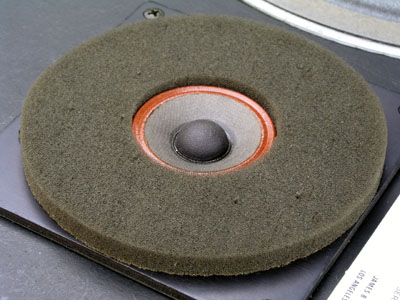
you have just to size it properly.
It will limit the emission angle of the tweeter.
KEF make a few floorstanding speakers that use a Uni-Q drive unit almost identical to the LS50's, combined with several large woofers.
Basically a 3-way made by combining a LS50 with a passive sub.
I think this is a better idea than simply trying to make the LS50 drive unit bigger, which would cause the tweeter to become a dome midrange and run out of high end
Being set on the 3-way solution I have for long time searched which could be the best cut point between woofer and mid (in this case the coaxial woofer).
Many place the point at 120-150 Hz.
I think that for high SPL the 4" Uni-Q of the ls50 would be a little stressed.
200 Hz would be better (i.e. less distortion).
I would like to see a 7"-8" Uni-Q just upscaled from the ls50.
That would be something ...
But i agree with you. This generation of Uni-Qs is very impressive indeed.
And in some way better than the Tannoy DC in the midband ... better transition between the two drivers maybe ?
Regards, gino
An externally hosted image should be here but it was not working when we last tested it.
First, Precision 8's are remarkably disappointing speakers. I put their intrinsic value at less than 300 cents. The aforementioned System
800s are much better, and the System
8 NFM II is better still.
Second, KEF does make a speaker with an 8" concentric. The Q900.
800s are much better, and the System
8 NFM II is better still.
Second, KEF does make a speaker with an 8" concentric. The Q900.
Here's a phase measurement I made of my Precision 6's (in blue) overlayed with a MarkAudio CHR-70.3 in a DCR box I built (in purple) using a swept sine technique in REW.
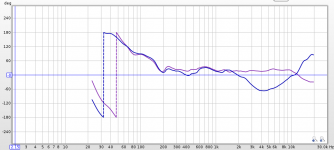
Clearly their brochure is misrepresenting their product.
It should be noted this was an in-room measurement with both speakers in the same spot and the microphone in the same spot. Room colourations should be viewable as bumps/dips that appear in both lines.
Additionally, another method for recessing the acoustic centre of the tweeter (provided the dispersion of it is good) is to angle it upward. I tried this in a different build of mine as pictured below.
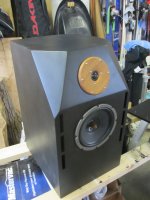

Clearly their brochure is misrepresenting their product.
It should be noted this was an in-room measurement with both speakers in the same spot and the microphone in the same spot. Room colourations should be viewable as bumps/dips that appear in both lines.
Additionally, another method for recessing the acoustic centre of the tweeter (provided the dispersion of it is good) is to angle it upward. I tried this in a different build of mine as pictured below.

Last edited:
First, Precision 8's are remarkably disappointing speakers. I put their intrinsic value at less than 300 cents
Hi and 😱 ... why you say so ? in which way they have disappointed you ?
i am sincerely interested ... i have not bought them yet.
Are you referring to passive or active version ?
The aforementioned System 800s are much better,
and the System 8 NFM II is better still
Again ... in which way ?
I was thinking to disconnect the tweeter and redo the x-over to use only the DC ... 15kHz for me are enough ... i cannot listen above ... 😱
Second, KEF does make a speaker with an 8" concentric. The Q900.
I see now. Thanks ! very interesting ...
I wonder why they do not offer a bigger version of the ls50 with this 8" driver.a class-beating 200mm (8in.) in the flagship of the range, the magisterial Q900
I should email them ... it could be a very good speaker also for professional monitoring duties to be listened in the nearfield.
I like coaxials in general and thi Kef interpretation in particular.
Kind regards, gino
Here's a phase measurement I made of my Precision 6's (in blue) overlayed with a MarkAudio CHR-70.3 in a DCR box I built (in purple) using a swept sine technique in REW.
View attachment 459557
Clearly their brochure is misrepresenting their product.
It should be noted this was an in-room measurement with both speakers in the same spot and the microphone in the same spot.
Room colourations should be viewable as bumps/dips that appear in both lines.
Hi and thanks a lot for the extremely interesting graph.
But it is really so different from that of the brochure ?
As you say the measurements depend from room features so maybe the testing room of Tannoy was different.
They seem to me quite comparable results.
Additionally, another method for recessing the acoustic centre of the tweeter (provided the dispersion of it is good) is to angle it upward.
I tried this in a different build of mine as pictured below.
View attachment 459558
Very interesting but i was thinking about the centers of emission alignment thing.
1ms of delay considering the speed of sound is roughly equivalent to 340 mm.
This is a lot indeed and i am sure no human ear is able to hear a delay of 1ms, with 4ms a more likely value (but someone put the limit at even 10ms, i do not know if they are right or not).
Now 4ms of delay correspond to 4*340= 1.36 meters of distance between the centers of emission 😱
Every normal speakers satisfy this requirement ... so the alignment should not be a real problem.
Moreover ... even flatness of response seems to be a non issue, with the ear unable to catch variation of less than +/- 5dB.
This should mean that a response within +/-5dB is perceived as flat by a human ear.
We are clearly overestimating the ability of human ears.
Ok ... there are still the Golden ears ...

Thanks a lot, gino
Did you see the measurements I posted? I was never quite happy with my System 800s, I felt they had a weird recessed, phasey quality to the midrange. I recently measured them and found they had a 10dB notch over about 1/2 octave at the crossover frequency. I hope this is a factory quality control issue and they are not all like that.First, Precision 8's are remarkably disappointing speakers. I put their intrinsic value at less than 300 cents. The aforementioned System
800s are much better.
Did you see the measurements I posted?
I was never quite happy with my System 800s, I felt they had a weird recessed, phasey quality to the midrange.
I recently measured them and found they had a 10dB notch over about 1/2 octave at the crossover frequency
I hope this is a factory quality control issue and they are not all like that.
Hi and this is a lot indeed. Strange.
I would have looked at the x-over
I think that the raw drivers should be quite linear ... and i would be surprised that the 10dB notch is the effect of the waveguide loading the tweeter.
That would make the balancing very very difficult.
I would try to get the freq response of only the tweeter connected without filter and see its flatness and the effect of the waveguide on its response
Is it possible that this 10dB peak comes from the waveguide ?
Maybe a new x-over could be the key to a more balanced sound.
Thanks again, gino
Last edited:
Surely the point of buying a speaker instead of building it is that you don't have to get involved in crossover design? 😛
I posted the schematic of the crossover in the thread I linked, and the general response was "WTF". It is apparently quite different to the 8NFM2.
I posted the schematic of the crossover in the thread I linked, and the general response was "WTF". It is apparently quite different to the 8NFM2.
Hi and ok i have found the response and filter.
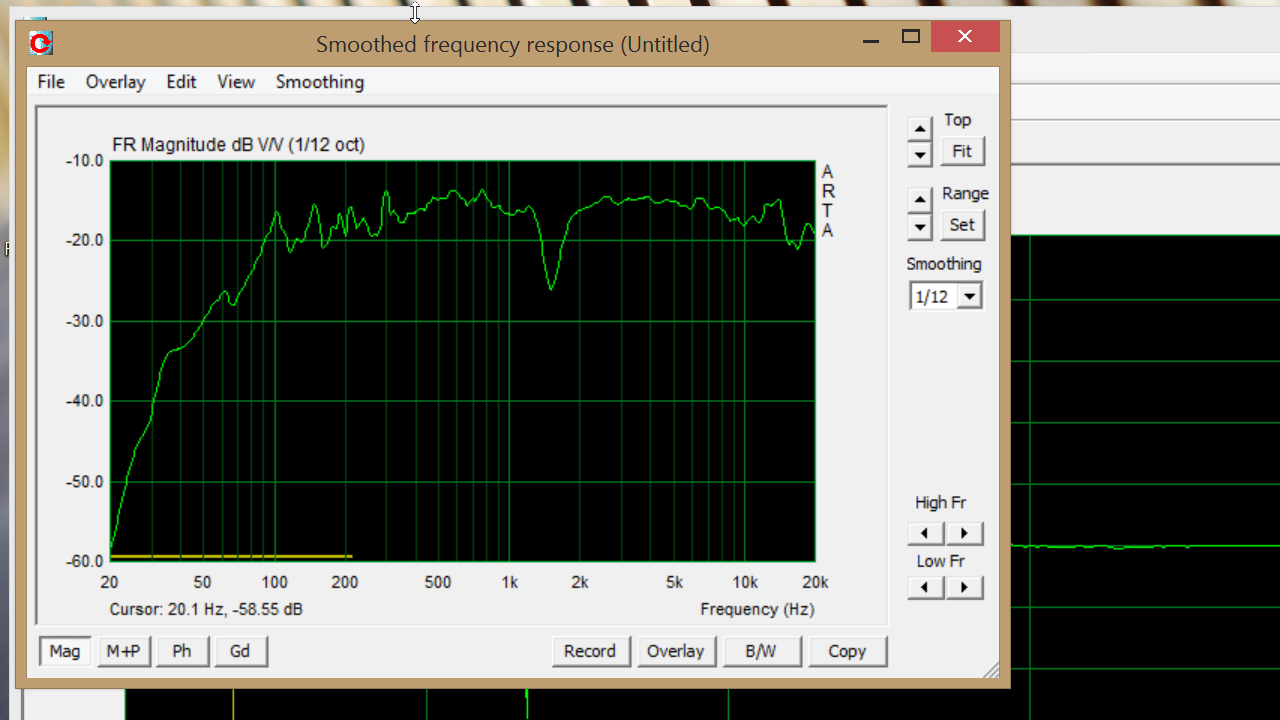
I was thinking completely to something else much more serious
For me wrong x-over it is clear
You should extend the response of the woofer to fill the gap in the freq response changing some values in the x-over.
If you manage to find the TS parameter of the two drivers just design another one very basic and the sound will be perfect.
I was thinking about some nasty peaks but there is no things like that.
Good to know also for me ... nice response. Only wrong values of some parts in the x-over.
It happens ... if you search the web you find many people modifying Tannoy original x-overs replacing parts and changing values.
Good luck ! Kind regards, gino

I was thinking completely to something else much more serious
For me wrong x-over it is clear
You should extend the response of the woofer to fill the gap in the freq response changing some values in the x-over.
If you manage to find the TS parameter of the two drivers just design another one very basic and the sound will be perfect.
I was thinking about some nasty peaks but there is no things like that.
Good to know also for me ... nice response. Only wrong values of some parts in the x-over.
It happens ... if you search the web you find many people modifying Tannoy original x-overs replacing parts and changing values.
Good luck ! Kind regards, gino
Last edited:
if you search the web you find many people modifying Tannoy original x-overs replacing parts and changing values.
Surely the point of buying a speaker instead of building it is that you don't have to get involved in crossover design? 😛
.
Would you like to buy a pair of System 800s?
Hi and thanks a lot for the extremely interesting graph.
But it is really so different from that of the brochure ?
As you say the measurements depend from room features so maybe the testing room of Tannoy was different.
They seem to me quite comparable results.
Did you ignore everything above 2kHz? The room colouration is identifiable by the bumps seen in both lines. The Tannoys look to follow the 'Phase not independent of frequency' graph in their brochure, rather than the flat 'Phase idependent of frequency' graph that they claim represents their product.
Very interesting but i was thinking about the centers of emission alignment thing.
1ms of delay considering the speed of sound is roughly equivalent to 340 mm.
This is a lot indeed and i am sure no human ear is able to hear a delay of 1ms, with 4ms a more likely value (but someone put the limit at even 10ms, i do not know if they are right or not).
Now 4ms of delay correspond to 4*340= 1.36 meters of distance between the centers of emission 😱
Every normal speakers satisfy this requirement ... so the alignment should not be a real problem.
Moreover ... even flatness of response seems to be a non issue, with the ear unable to catch variation of less than +/- 5dB.
You're mixing up psychoacoustic test results. The difference in phase shift and time alignment is a significantly different aspect of our hearing than the 10ms discrimination of separate sounds aspect. I'm sure most humans are able to hear delays of 1ms as this is well above the level of inter-ear time delays that we rely very heavily on for sound localization.
The amplitude differences you've thrown out also seem baseless and blatantly wrong.
Would you like to buy a pair of System 800s?
Thanks for the offer
Well i like your Tannoy but really i have quite a few speakers already myself
To be precise already 4 pair of cheap Tannoys: DC100, 609, 611, 622
I have also this opportunity on a pair of Precision 8P very cheap indeed that i am evaluating.
But i would do a sacrifice only for the System 8 or similar ... if i were not always on the move, for their fantastic cabinets of heroic construction
One of the best cabinet around .. extremely stiff and damped.
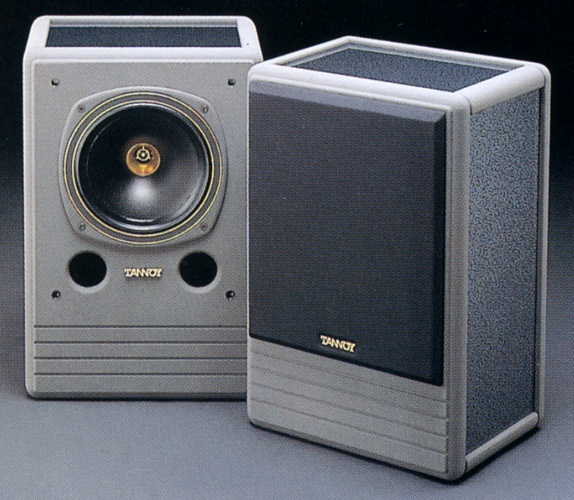
And I understand that modifying something is not a good thing in case of future sale. Only pro mods are accepted by buyers.
Thanks anyway. Regards, gino
Last edited:
Did you ignore everything above 2kHz?
The room colouration is identifiable by the bumps seen in both lines.
The Tannoys look to follow the 'Phase not independent of frequency' graph in their brochure, rather than the flat 'Phase idependent of frequency' graph that they claim represents their product.
Hi what i mean is that in other cases i have seen much worse FR than these that for me are quite ok, quite linear.
Just look at the measurements carried-out by Stereophile magazine .., like this one
Zu Essence loudspeaker Measurements | Stereophile.com
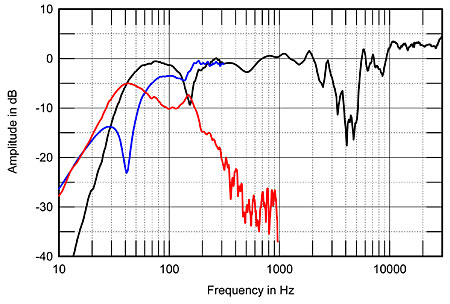
Nevertheless the speaker was extremely well judged on the basis of the listening tests.
And i completely believe not only in the bona fide of the reviewers but also in their experience because they listen for profession.
This to me means mainly one thing ... we do not know exactly what makes a speaker good or bad sounding ... that is the point.
I have a personal opinion ... low distortion is very very good.
But it is just an opinion.
You're mixing up psychoacoustic test results. The difference in phase shift and time alignment is a significantly different aspect of our hearing than the 10ms discrimination of separate sounds aspect. I'm sure most humans are able to hear delays of 1ms as this is well above the level of inter-ear time delays that we rely very heavily on for sound localization.
Have you tried ? I read a very telling experiment.
Same impulse on the two L and R at the same time.
Then to one channel a digital delay applied
I do not remember precisely but the listener started to perceive the delayed signal as weaker only at around 4 ms of delay ... increasing the delay gave an echo effect.
But if you have tried is interesting to get another opinion.
I should have said better ... in some tests a speaker with a very up and down FR was judged positivelyThe amplitude differences you've thrown out also seem baseless and blatantly wrong
The fact that the manufacturers give usually the FR +/-3dB should mean something
But in the case of these Tannoy, aside the gap between the drivers that can be easily cured, they seem pretty linear to me
The listening room could impact the FR a lot more, as you also say i think.
Regards, gino
Last edited:
Hi what i mean is that in other cases i have seen much worse FR than these that for me are quite ok, quite linear.
The graph I posted was a phase resonse graph, not a frequency response graph. Judge apples with apples, not apples with horses.
Edit: just noticed the article you linked has one phase graph that has very different scales than the graph I posted. The speaker in question in that article seems to have a similar but better phase response than the Tannoys, assuming the same general measurement process.
Last edited:
The graph I posted was a phase resonse graph, not a frequency response graph. Judge apples with apples, not apples with horses.....
Here's a phase measurement I made of my Precision 6's (in blue) overlayed with a MarkAudio CHR-70.3 in a DCR box I built (in purple) using a swept sine technique in REW.

Clearly their brochure is misrepresenting their product.
It should be noted this was an in-room measurement with both speakers in the same spot and the microphone in the same spot.
Room colourations should be viewable as bumps/dips that appear in both lines
Hi and i try to understand again ... i am a little slow.
The MarkAudio CHR-70.3 in a DCR box are very good at this test ... clearly superior to the Tannoys ... that still are not that bad ?
Am i right ? or are the Tannoys really bad ?
What would be the perfect Phase Response Graph then ?
Thanks again for the graph. Regards, gino
Last edited:
Hi and i try to understand again ... i am a little slow.
The MarkAudio CHR-70.3 in a DCR box are very good at this test ... clearly superior to the Tannoys ... that still are not that bad ?
Am i right ? or are the Tannoys really bad ?
What would be the perfect Phase Response Graph then ?
Thanks again for the graph. Regards, gino
I believe your last question was answered in post #4 of this thread. The Tannoys aren't horrible, just not the best and particularly not as good as their advertising suggests/claims.
I believe your last question was answered in post #4 of this thread. The Tannoys aren't horrible, just not the best and particularly not as good as their advertising suggests/claims.
Hi and thanks and very interesting
Do you think that the non-linearity of the tweeter could be the result of the action of the waveguide ?
I would understand those who prefer the Kef coaxial without waveguide.
Thanks again, gino
Last edited:
In a swept sine test the waveguide (woofer) would be stationary during the tweeter portion of the sweep. Under real-world conditions, the modulation/action of the waveguide would likely have more effect on the THD measures than phase measures.
- Status
- Not open for further replies.
- Home
- Loudspeakers
- Multi-Way
- Tannoy DC and phase response.